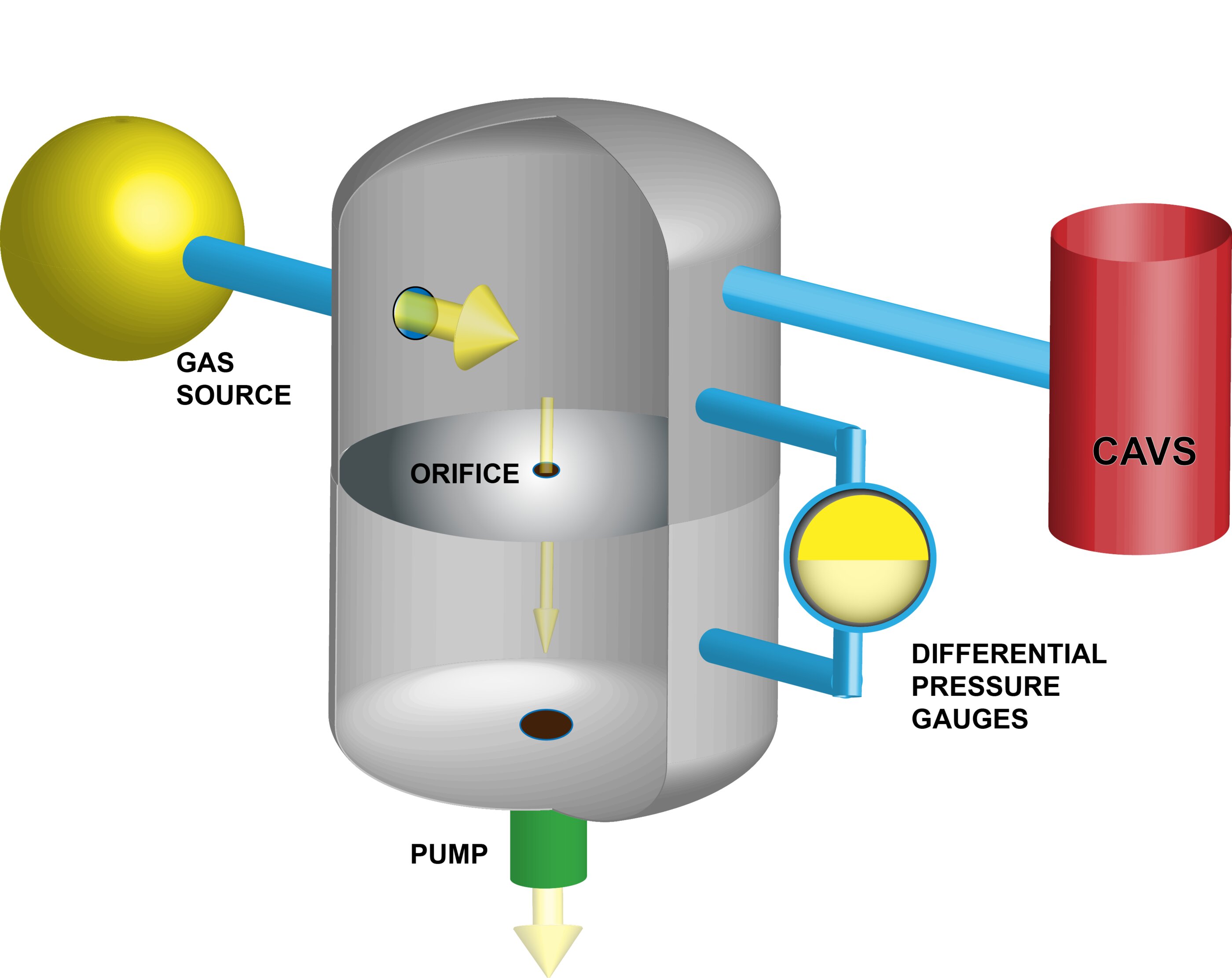To validate their new approach for measuring ultra-low vacuum pressures, scientists at the National Institute of Standards and Technology (NIST) constructed an advanced version of a traditional pressure metrology setup called a dynamic expansion system. The system involved injecting gas into the top chamber at a flow rate of approximately 10 to 100 billion molecules per second. The gas then moved from the upper chamber to the lower chamber, which was evacuated by a powerful pump, at a known rate through a precisely dimensioned orifice. Gauges were used to measure the pressure ratio between the two chambers and make corrections for any imperfections. By utilizing the gas flow rate and the rate at which gas moved between the chambers, the researchers were able to calculate the pressure in the top chamber, which was then independently measured by the CAVS (cold atom vacuum standard) technology. The researchers found that the known pressure value and the readings from the CAVS sensors matched, providing validation for their innovative method.
A vacuum chamber is never completely empty; a few atoms or molecules always remain. Accurately measuring the minuscule pressures exerted by these particles is crucial, particularly in semiconductor manufacturing, where the creation of microchips necessitates an almost contaminant-free vacuum environment. Therefore, monitoring the gas pressure in the chamber is vital to ensure acceptably low levels of contaminants. The NIST scientists have now demonstrated a new technique called CAVS, which effectively measures extremely low gas pressures. They have established that CAVS can serve as a primary standard, meaning it can provide accurate measurements without the need for calibration to reference pressure readings. Over the course of seven years, the researchers developed and refined CAVS, subjecting it to rigorous testing in their most recent study. The results, published in the journal AVS Quantum Science, showed that CAVS produced measurements that aligned with those obtained using the traditional “gold standard” method for measuring low pressures. This validates the accuracy and reliability of CAVS, which can not only match the performance of traditional pressure gauges but can also effectively measure even lower vacuum pressures required for future chip manufacturing. Furthermore, CAVS operates based on well-established principles of quantum physics, allowing it to provide accurate readings “out of the box” without the need for adjustments or calibration to other reference sources or techniques.
NIST physicist Julia Scherschligt emphasized the significance of this achievement: “This is the culmination result. We have had numerous positive developments before. But this validates the fact that our cold atom standard is truly a standard.” The applicability of CAVS extends beyond semiconductor manufacturing and can be beneficial in various applications that rely on high-vacuum environments, such as quantum computers, gravitational wave detectors, and particle accelerators. CAVS technology utilizes a cold gas containing around a hundred thousand lithium or rubidium atoms trapped in a magnetic field. These atoms emit fluorescence when illuminated by a laser of a specific frequency, allowing researchers to precisely count the number of trapped atoms by measuring the intensity of the emitted light. When the CAVS sensor is connected to a vacuum chamber, the remaining atoms or molecules in the chamber collide with the trapped atoms, causing a reduction in the number of atoms and the emitted light’s intensity. This change in intensity serves as a sensitive measure of pressure. Quantum mechanics predicts precisely the relationship between the rate of dimming and the number of molecules involved in the collisions.
In their study, the NIST researchers integrated their CAVS sensors with a classical gold-standard reference system for gas pressure known as a dynamic expansion system. These systems work by injecting a known amount of gas into a vacuum chamber and then gradually removing the gas from the other end of the chamber at a known rate. The resulting pressure in the chamber can then be calculated. For this particular experiment, the researchers developed an advanced dynamic expansion system capable of handling extremely low gas flows, ranging from 10 billion to 100 billion atoms or molecules per second. Additionally, they incorporated a custom-built flowmeter to accurately measure such low gas flows. The orifice designed to remove atoms from the chamber was precisely machined to submicrometer levels. Despite the significant effort required to establish and operate a classical standard device, the researchers found that CAVS provided high accuracy in a much simpler form.
During their work, the NIST team tested two types of CAVS sensors: a laboratory version and a mobile version suitable for advanced chip manufacturing environments. The simplicity of the portable CAVS allowed for automation, minimizing the need for intervention during its operation. In fact, a considerable portion of the data collected from the portable CAVS for this study was obtained while the researchers were comfortably asleep at home. The gases measured in the study, including nitrogen, helium, argon, and neon, are all inert semiconductor process gases. However, the researchers aim to extend the measurements to more reactive gases such as hydrogen, carbon dioxide, carbon monoxide, and oxygen, which are common residual gases in vacuum chambers and useful for semiconductor manufacturing.
The successful development and validation of CAVS offer significant potential for researchers working with ultralow pressures and have implications for advancements in both science and technology.
Denial of responsibility! SamacharCentrl is an automatic aggregator of Global media. In each content, the hyperlink to the primary source is specified. All trademarks belong to their rightful owners, and all materials to their authors. For any complaint, please reach us at – [email protected]. We will take necessary action within 24 hours.

Shambhu Kumar is a science communicator, making complex scientific topics accessible to all. His articles explore breakthroughs in various scientific disciplines, from space exploration to cutting-edge research.


